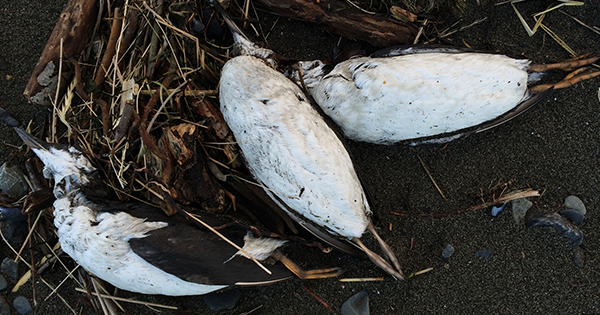
My husband says I’ve been a downer lately. It’s hard not to be. We’ve had day after day of dark, rainy weather. In town, the rain has melted away all the snow, which is our winter fun and the bright whitewash on these dreary midwinter weeks. But what is hardest to cope with is a massive die-off of one of our most charming local seabirds—the common murre. They’re washing up on area beaches seemingly by the thousands. You have to tread carefully not to step on their carcasses.
The common murre, a beautiful, penguin-like bird, is one of the wild characters that populate our lives. In the summer, from the beach or a boat, you can watch long lines of these birds fly out toward the mouth of the bay to feed and then zoom back to where they nest in a crowded colony on Gull Island, a few rocks sticking out of the bay. The female murre lays a speckled, cone-shaped egg, so pointy at one end it will roll in a circle, helping keep the eggs on their narrow cliffside nests from falling into the sea.
Common murres eat small fish and can dive as deep as 600 feet for them, using their wings to swim. A four-hour drive from here, in Seward, is the Alaska Sealife Center, where you can watch the murres fly underwater in a two-story glass tank. Around Gull Island, the raft of murres is so thick, it turns the sea black.
These creatures are animals of the sea, never straying far from water. But this winter they’ve been found as far inland as the Fairbanks area—some 300 miles from the coast. One of Alaska’s most famous mushers—four-time Iditarod champ Jeff King—found a couple of these birds alive, although likely barely so, in the snow while running his dogs near Denali. The story popped up all over statewide media.
Alaskans who have lived here a while remember the massive die-offs of these birds in 1970 and in the early 1990s. But the stories of those die-offs don’t provide enough clues to answer the question: Why are the birds dying now?
Scientists don’t yet know. The birds appear to have starved to death. But why? Is it because humpback whales lingered longer in the north this fall—a dozen or more in our bay as late as November, months after they normally would have left for California and Mexico—and have scooped up all of the bait fish? Is it El Niño? The recent storms? The warm blob? Is it related to the bloom of toxic algae that appeared in Alaska waters this summer, likely fueled by warmer waters? Is this just one of the many tendrils of climate change?
Sometimes living here, surrounded by such exceptional beauty, is hard. We watch as a new subdivision gets scraped out of moose habitat, where there has never before been human development. Or—even in the decade and a half since I moved here—beaches are closed to clamming, or the spot you always boated to for steamers just doesn’t have any anymore. We constantly wonder: Is this the face of things to come? Is this just one of many of the ways climate change is going to transform this place we love?

